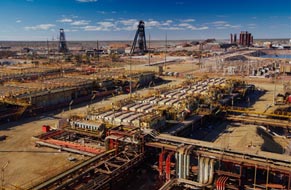In a presentation to analysts, BHP Billiton has set out its five stages for developing its Olympic Dam mine in South Australia, with a "focus on simplicity and preservation of future options."
 |
| Olympic Dam (Image: BHP Billiton) |
Stage 1 of the expansion involves an optimisation of the present plant and mine. This will take until 2013, representing a delay in the whole scheme. It involves treating an extra 2 million tonnes of ore per year, and increasing uranium output to 3820 tonnes (4500 tonnes U3O8).
Thereafter there are three steps, each of 20 million tonnes per year, in ore production to 72 million tonnes per year, with annual uranium output of 16,000 tU.
BHP Billiton has been working on improving uranium recovery - much of the mineral is brannerite, and recoveries have been below 70%. This year, 72.8% overall recovery has been achieved.
The plan confirms that much of the copper concentrate will be exported for smelting in China, and this will have enough uranium still present to require the application of safeguards. Australia has a bilateral safeguards treaty with China, and Energy Resources of Australia (ERA), owner of the Ranger mine in Northern Territory, has started selling uranium to China.
With eventually two-thirds of the copper concentrate from the expanded operation being exported as concentrate, up to 3000 tonnes of uranium will be involved. The major part of the uranium - some 13,000 tU per year - would be recovered and processed as at present (by acid leaching the copper tailings - 80%, and acid leaching the copper concentrate - 20%). This copper concentrate export strategy for the expanded production from Olympic Dam will diminish the investment cost of the expansion, since smelting and refining for most of the copper increment will not be required. The infrastructure needed at Olympic Dam to operate it - notably electricity - will also be less. A new smelter in China will be lower cost.
Plans for expansion of the mine will mean that 800,000 tonnes per year of copper concentrate is smelted at the site to produce just over half of the copper product, and 1.6 million tonnes is exported to be smelted in China. This lower-grade portion (mostly chalcopyrite - CuFeS2) will have about 2000 tonnes of uranium in it (less than 20% of total U) to be recovered there. Total uranium production would then be 16,000 tU (19,000 tonnes U3O8) per year - with 730,000 tonnes of copper and 25 tonnes of gold.
In the presentation, BHP Billiton defined five stages of this expansion, without a specific timeline. In the first stage, existing operations will be optimised by 2013, taking ore treatment to 12 million tonnes per year from underground and uranium production to 4500 tonnes U3O8 per year. The second stage involves developing 20 million tonnes per year open pit ore supply, building a new copper concentrator and uranium leach plant, with increment of copper concentrate being sold to China and processed there at a dedicated new smelter. Annual uranium production at this stage will increase to 9000 tonnes U3O8.
In the third stage, the existing copper smelter on site will be expanded for high-grade concentrate. Uranium production will remain at 9000 tonnes U3O8 per year during this stage. The fourth stage, concurrent with the third, involves expanding open pit ore supply to 40 million tonnes per year and new copper concentrator and uranium leach capacity accordingly. Low-grade copper concentrate will be sold to the Chinese smelter. Uranium production will then increase to 14,000 tonnes U3O8 per year. In the fifth stage, open pit ore supply will be expanded to 60 million tonnes per year, and new copper concentrator and uranium leach capacity will be built accordingly. Low-grade copper concentrate will be sold to the Chinese smelter. Uranium production will at this stage be increased to 19,000 tonnes U3O8 per year (16,000 tU).
Eventually the pit will swallow up the present treatment complex. Its final dimensions will be almost 7 km x 4.5 km and 1.2 km deep.




_18570.jpg)
_16159.jpg)
_18938.jpg)
_33584.jpg)





